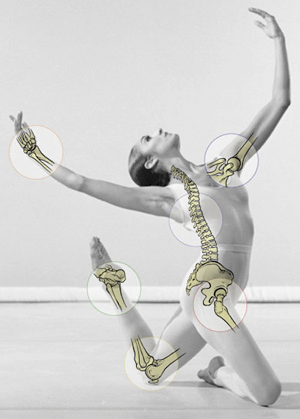Dance is a physically demanding sport, which requires extreme strength, flexibility and endurance. These qualities not only allow the dancer to perform at a high skill level, but also help to prevent the occurrence of many injuries. Without the qualities of strength, flexibility and endurance, a dancer physically cannot challenge the limits of athleticism or reach their full physical potential.
 There is a strong link between the level of physical fitness, particularly in terms of strength, and the development of dance related injuries. Did you know that the incidence of lifetime injury in dancers is ninety percent, with thirty-fifty percent of dancers being injured in a given year? Also, a significant risk factor for injury is the presence of a previous injury. These well-researched facts demonstrate the need for dance injuries to be accurately diagnosed, assessed and managed, in order to prevent an injury, or re-occurrence of an injury, from happening. Additionally, they demonstrate the importance for performing artists to participate in physical screens and biomechanical assessments with a health professional in order to reveal any functional limitations or faulty movement patterns that may predispose the dancer to injury. continue reading
There is a strong link between the level of physical fitness, particularly in terms of strength, and the development of dance related injuries. Did you know that the incidence of lifetime injury in dancers is ninety percent, with thirty-fifty percent of dancers being injured in a given year? Also, a significant risk factor for injury is the presence of a previous injury. These well-researched facts demonstrate the need for dance injuries to be accurately diagnosed, assessed and managed, in order to prevent an injury, or re-occurrence of an injury, from happening. Additionally, they demonstrate the importance for performing artists to participate in physical screens and biomechanical assessments with a health professional in order to reveal any functional limitations or faulty movement patterns that may predispose the dancer to injury. continue reading
What are the most common dance related injuries?
- FOOT

- Plantar Fasciitis
- Metatarsalgia
- ANKLE
- Ankle Sprain
- Achilles Tendinopathy
- KNEE
- Patellar Tendinopathy
- Iliotibial Band Syndrome
- HIP
- Iliopsoas (Hip Flexor)
- TENDINOPATHY
- Snapping Hip Syndrome
- Tight External or Internal Hip Rotators
- Groin Muscle Strain Spain
- Lumber Cervical
- SPINE
- Lumbar and Cervical Facet Irritation (Low Back or Neck Pain)
- Sacroiliac Dysfunction or Irritation
The most common injury faced by dancers is in the foot or ankle (53%), followed by injuries of the hip (21.6%), knee (16.1%) and back (9.4%). The most common movements to cause injury are jumps, specifically, how the dancer lands their jumps. A chiropractor has the ability to assess movement patterns, like the landing of the jump, in order to identify any factors that may predispose a dancer to injury. Specific findings are linked to specific injuries. For example, if a dancer has a tendency to over-pronate (roll their ankles inwards) when landing a jump, they have a greater likelihood of knee injury.
I found out that I had weak lower abs and a tight IT band. Since doing all the prescribed exercises, my turns and jumps have both improved. I never realized that going to a chiropractor could improve my technique.
Gabrielle Thurlow, Pittsburgh Ballet Theatre corps member
Another important consideration regarding the cause of injury in dancers is fatigue. A dancer’s training regime, especially around performance time, is extremely physically and emotionally demanding. A discrepancy exists between the cardiovascular demands of class, compared to a performance. Ideally, two-three aerobic training sessions should be performed each week to help the dancer prepare for performance time. Teachers can incorporate aerobic training into their classes by increasing the length of an exercise and reducing the rest periods between each exercise. This simple modification may help prevent an injury caused by fatigue during a performance.
How well a dancer is informed about injury care plays a role in their successful recovery and return to dance. Immediately after an injury, it is recommended that the dancer use the PRICED method in order to reduce any swelling and protect the injury until seeking medical care. Conversely, knowing what to avoid after an injury is important; avoid anything that will increase blood flow to the injured area (heat, massage). While rehabilitating an injury, focus on the entire body, and not solely the injured body part; cardiovascular fitness, restoring strength, balance and flexibility in bilateral limbs and proper nutrition all play vital roles in recovery. continue reading
What should I do immediately after an injury?
PRICED METHOD
PROTECTION – Stop dancing, limit movement of the injured part, stabilize the injured area or limit weight bearing (compression wrap, crutches, tape or splint)
REST – Stop moving the injured body part, speak with a doctor about the amount of rest required for your specific injury
ICE – Apply ice to the injured area for twenty minutes every two hours to decrease pain and swelling
COMPRESSION – Wrap the injured body part in a compression bandage to reduce swelling
ELEVATION – Raise the injured body part above the heart
DIAGNOSIS – A chiropractor is a musculoskeletal specialist and has the training to diagnose and manage injuries. A chiropractor will develop an individualized rehabilitation program that will help speed up recovery and prevent the injury from reoccurring.
The difference between stretching and warming up is another important topic when discussing dance related injuries. Stretching is not the same as warming up! The purpose of a warm up is to increase the temperature of the muscles that will be used, by increasing circulation and blood flow, which should be done prior to class or performance. Conversely, the best time to stretch is after a dance class or performance. Once muscles have been exercised, they will be warm, more responsive to stretch and much more extensible. Also, stretching at higher body temperatures is linked to a decreased chance of injury and longer lasting changes in flexibility and muscle length, which is the ultimate goal of stretching.
Stretching For Dancers – Key Points
WHEN to stretch – stretch when muscles are warm (after class or performance)
HOW LONG to stretch – 30 second stretches, 3-5 times per muscle
HOW OFTEN to stretch – once a week to maintain range of motion and flexibility, three – five times per week to increase flexibility
AGE and GENDER differences – females are more flexible than males at similar ages, children are less flexible during skeletal growth spurts (age 10-12), which corresponds to higher chances of injury at these ages.
Click Here for the PDF version
About Author
 Dr. Caitlin McAlpine
Dr. Caitlin McAlpine
Dr. Caitlin McAlpine is a graduate from the Canadian Memorial Chiropractic College. While completing her four-year doctorate program, she furthered her studies at McMaster University and is also a certified Contemporary Medical Acupuncture provider. Prior to her CMCC education, Dr. McAlpine attended the University of Western Ontario and graduated in 2009 with an honours specialization degree in Kinesiology.




 Dr. Caitlin McAlpine
Dr. Caitlin McAlpine


